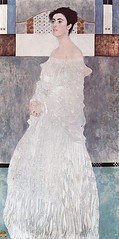
 In 1925, Margaret Stonborough also commissioned her brother Ludwig--then a gardener in a nearby monastery--as an architect to design a large house for her in Vienna. Wittgenstein worked alongside Paul Engelmann, his friend from the army. Just to get an idea of how all the modernist movements are intertwined (not necessarily harmoniously), Engelmann had studied under Adolf Loos, who was also a friend of Wittgenstein. Loos basically bashed the Vienna Secession, whose building Wittgenstein's father had financed.
In 1925, Margaret Stonborough also commissioned her brother Ludwig--then a gardener in a nearby monastery--as an architect to design a large house for her in Vienna. Wittgenstein worked alongside Paul Engelmann, his friend from the army. Just to get an idea of how all the modernist movements are intertwined (not necessarily harmoniously), Engelmann had studied under Adolf Loos, who was also a friend of Wittgenstein. Loos basically bashed the Vienna Secession, whose building Wittgenstein's father had financed. Addendum:
I got a helpful comment from a reader on Lumberjocks (where i also post my blog), as well as some suggested reading. I thought i would post it here so we can all benefit. Thanks, JL Smith!
As a result of my education (both formal and informal) I have a pretty good grasp of the Vienna Secession particularly from an architectural and painting perspective. I have always found it interesting that the movement imposed no aesthetic dogma but instead focused on producing modern works of art. My understanding of the context beyond the artistic world has always been somewhat limited. I am sure you know that Art and Architectural history professors typically don’t like to teach social and political history. For the most part it seems if one whats to understand the art world in it’s broader context they will have to do it on their own.
I don’t know if these reading suggestions will align with your interests or not but I have read them and found them interesting. They cast a wider net then most art/architectural books do regarding context (the widest context is probably the Judgment of Paris).
These three are by Ross King
The Judgment of Paris: The Revolutionary Decade that Gave the World Impressionism
Michelangelo and the Pope's Ceiling
Brunelleschi's Dome: How a Renaissance Genius Reinvented Architecture
Gregory Curtis wrote
The Cave Painters: Probing the Mysteries of the World's First Artists
Philip Steadman wrote
Vermeer's Camera: Uncovering the Truth behind the Masterpieces

No comments:
Post a Comment